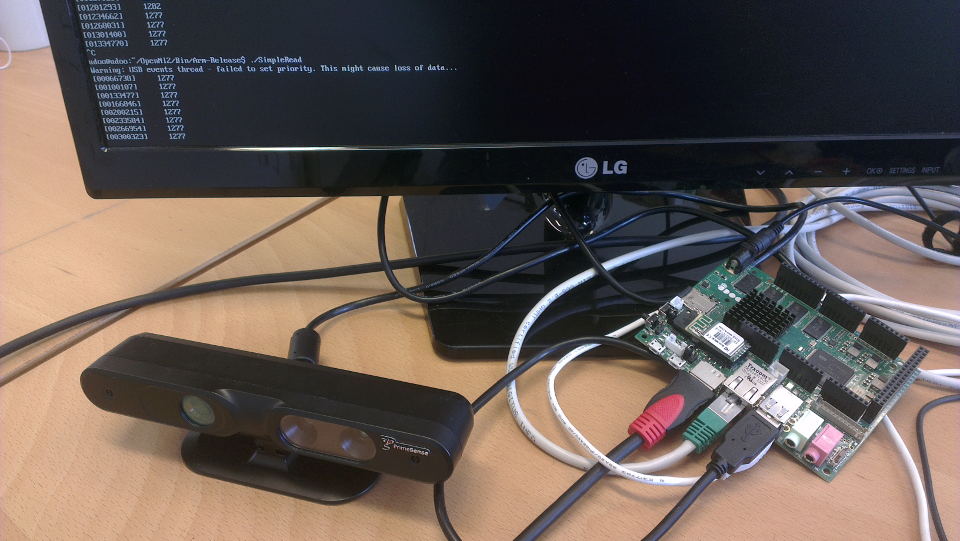Asus Xtion on UDOO with OpenNI2 and ROS

This step by step tutorial shows how to setup the UDOO in order to use an Asus Xtion with ROS. If ROS is not necessary, follow this tutorial alternatively and go directly to step 2.
Step 1: Install ROS on UDOO
To use ROS on the UDOO set up an sdcard with an ubuntu core, following the steps described here with these modifications:
-
Instead of downloading the kernel, u-boot and modules seperately, download the Update Package found under the tab Driver & Tools on the udoo download page here
-
Depending on the udoo cpu, use the following command to flash the boot sector: (replace by u-boot-q.imx for the quad)
sudo dd if=u-boot-d.imx of=/dev/sdb bs=512 seek=2 status=noxfer -
Fix hostname problem. first add a correct hostname
sudo nano /etc/hostnamethen add that hostname to the file /etc/hosts
sudo nano /etc/hostsby adding this line (Replace
with the hostname defined above) 127.0.0.1 localhost <HOST_NAME>then reboot.
-
To use the WiFi module, the firmware has to be installed seperately and can be found here
sudo dpkg -i firmware-ralink_0.41_all.deb
Step 2: Install OpenNI2 Driver
Minimal Install
To use OpenNI2 with ROS, we only need the shared OpenNI2 libraries and the Drivers. Java is not necessary and doesn’t need to be compiled. So to avoid installing and using up unneccessary space, I describe here first the minimal solution, and later the additions necessary to compile the java code and create an archive.
Install the following dependencies:
sudo apt-get install git g++ make python libusb-1.0-0-dev libudev-dev pkg-config
clone OpenNI2
git clone https://github.com/OpenNI/OpenNI2
cd OpenNI2
edit ThirdParty/PSCommon/BuildSystem/Platform.Arm
nano ThirdParty/PSCommon/BuildSystem/Platform.Arm
and replace
CFLAGS += -march=armv7-a -mtune=cortex-a9 -mfpu=neon -mfloat-abi=softfp #-mcpu=cortex-a8
with
CFLAGS += -march=armv7-a -mtune=cortex-a9 -mfpu=neon -mfloat-abi=hard
then run make to compile the OpenNI2 drivers and libraries
PLATFORM=Arm make
Note: Because of the missing java compiler, the compilation will fail with OpenNI.java, and javac not found. This is ok since the drivers and shared libraries are already compiled at this point. The only thing missing are the samples.
Once the compilation is done, run the linux install script
cd /Packaging/Linux
sudo ./install.sh
copy libraries and includes to the system paths
sudo cp -r Include /usr/include/openni2
sudo cp -r Bin/Arm-Release/OpenNI2 /usr/lib/
sudo cp Bin/Arm-Release/libOpenNI2.* /usr/lib/
create a package config file
sudo nano /usr/lib/pkgconfig/libopenni2.pc
and fill it with this:
prefix=/usr
exec_prefix=${prefix}
libdir=${exec_prefix}/lib
includedir=${prefix}/include/openni2
Name: OpenNI2
Description: A general purpose driver for all OpenNI cameras.
Version: 2.2.0.0
Cflags: -I${includedir}
Libs: -L${libdir} -lOpenNI2 -L${libdir}/OpenNI2/Drivers -lDummyDevice -lOniFile -lPS1080.so
this will enable ubuntu to find the location of the drivers, libraries and include files.
To make sure it is correctly found, run
pkg-config --modversion libopenni2
which should give the same version as defined in the file above (2.2.0.0)
Now the Xtion is ready to be used. Plug it in (if it is already, unplug it first), then run the sample program
./Bin/Arm-Release/SimpleRead
Note: For the minimal install, the samples need to be compiled first. Add the following line to the makefile at the end
core_samples: $(CORE_SAMPLES)
then run
PLATFORM=Arm make core_samples
to compile the samples.
The SimpleRead returns the readings of middle point in the sensor data
./Bin/Arm-Release/SimpleRead
[00066738] 631
[00100107] 641
[00133477] 654
[00166846] 662
[00200215] 670
[00233584] 677
[00266954] 679
[00300323] 678
[00333692] 675
[00367061] 669
[00400431] 657
[00433800] 644
[00467169] 629
[00500538] 611
[00533908] 592
...
Full Install
in addition to the dependencies of the minimal install, the default-jdk package is needed:
sudo apt-get install default-jdk
now running
PLATFORM=Arm make
will compile the drivers, shared libraries, jar files and samples.
If a compressed archive with the drivers and libraries is needed, install the following:
sudo apt-get install doxygen
then run
cd Packaging
./ReleaseVersion.py Arm
which creates the archive OpenNI-Linux-Arm-2.2.tar.bz2 in Packaging/Final/
Step 3: Install ROS Packages to run the Asus Xtion
The packages used to run the Asus Xtion on the UDOO are not availbale over apt yet, so they need to be compiled from source
First install the following dependencies, which will take some time and space (~900MB):
sudo apt-get install ros-hydro-ros ros-hydro-rostopic ros-hydro-nodelet ros-hydro-camera-info-manager ros-hydro-roscpp ros-hydro-sensor-msgs ros-hydro-dynamic-reconfigure ros-hydro-image-transport ros-hydro-image-proc ros-hydro-depth-image-proc ros-hydro-tf
then create a catkin workspace as described here, and check out the following packages in the src folder of the catkin workspace:
git clone https://github.com/ros-drivers/openni2_camera
git clone https://github.com/ros-drivers/openni2_launch
git clone https://github.com/ros-drivers/rgbd_launch
Now the ros packages checked out above to the catkin workspace can be compiled with catkin_make
cd ~/catkin_ws
catkin_make
Once the packages are compiled, the Xtion is ready for use with ROS with
roslaunch openni2_launch openni2.launch
Performance on the UDOO is good with 30 Hz at 640x480, compared to the Raspberry Pi that can only provide 30 Hz at 320x240 under no other load.
blog comments powered by Disqus
